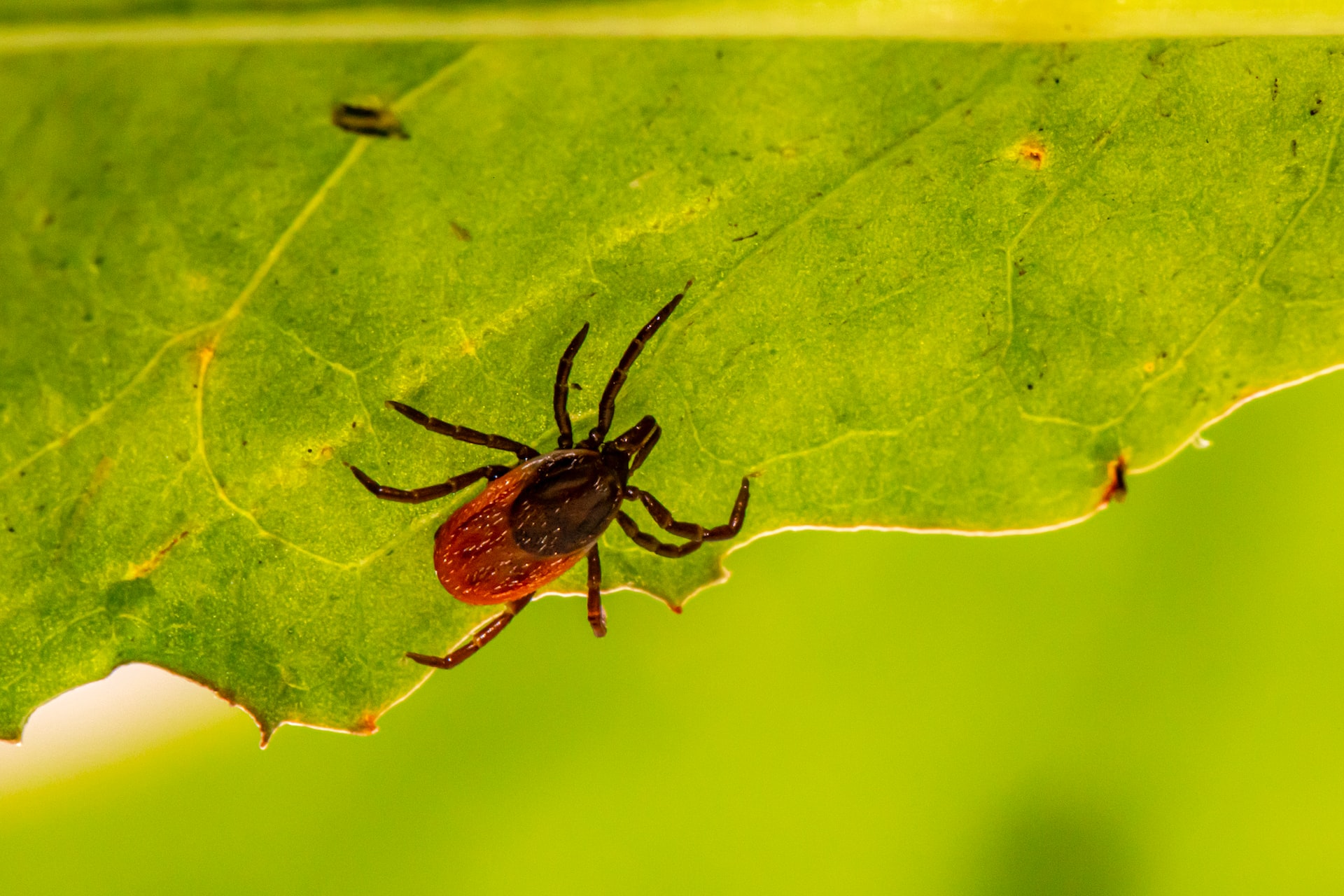With the summer heat sweeping across the island, it’s one of the best times of the year to get out and enjoy some of Long Island’s natural green trails. Many villages and towns will have paved paths for you to walk on, but some of you may be more inclined to dive deeper into some natural areas, and take walks in the wooded areas of the Pine Barrens. Wherever you end up going, though, it’s almost certain you’ve heard, either from a concerned friend or Facebook comment, about the rise in tick populations over the past few years.
For many of the tick species on Long Island, we’re actually in a bit of a lull, with many of them peaking in the spring and fall. However, even if adult populations have begun to dwindle, that’s no reason to disregard safety precautions when hiking in deep woods. For our friends outside of the Long Island area, certain species may still be in a state of high activity.
So this month, we’ll be going over the types of ticks to be on the lookout for, how to identify them on your person, what diseases they can carry, what to do to protect yourself from them, and what to do if one bites you. This post is about what to do if you are bitten by a tick, so we won’t be going over strategies to keep your dogs safe, though you should absolutely look into that yourself if you plan to take them hiking with you, or just if you tend to walk them in green areas.
The Types of Tick
While we’ll be focusing on the species prominent on Long Island in this blog, anyone who wants to protect themselves from ticks in any part of the United States should absolutely have a look at the tick finder published by the University of Rhode Island. The finder is an invaluable tool for determining not only what ticks may be prominent near wherever you live, but also during which months their activity is at its peak, and what diseases specific variants can carry. New York specifically will mostly see four kinds of tick: The Lone Star Tick (Amblyomma americanum), The American Dog Tick (Dermacentor variabilis), and The Deer Tick (Ixodes scapularis).
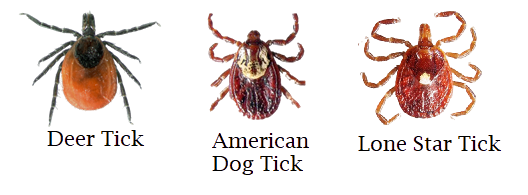
Right now, Long island, as well as the general tri-state, is actually seeing some of the lowest numbers for adult ticks we’ll have all year! And while you might assume that means there’s less to worry about, we still have larval ticks, and nymphs to worry about, which are currently at their peak for this year. The standard tick mating season happens to be right around now, so while the adults are beginning to die off, their spawn for the year will be coming in droves. Just because they’re smaller doesn’t mean you can ignore the threat of an immature tick; if anything, they’re even more dangerous because of their smaller size making them harder to find.
The fall is when adult ticks are at their absolute peak. If you’re willing to brave the cold, the winter months see populations drop massively, for both adults and larvae.
How to Identify a Tick
In addition to knowing the kinds of ticks that exist, it’s important as well to know what they’ll look like on your skin, as well as what a bite may look like. The most common advice about tick bites is to watch out for a bullseye rash, a large circular rash with a ring of red containing white skin within. However, this sort of rash only applies to Lyme disease, which is not the only way a tick bite may appear.
For any noninfectious tick bite, you’re likely to mistake it for a simple mosquito bite, and there isn’t as much to worry about. The odds are good that you might not even know you were bitten by a tick, since they are small enough to be mistaken for a freckle, and their bites are not likely to illicit pain similar to a small pinch.
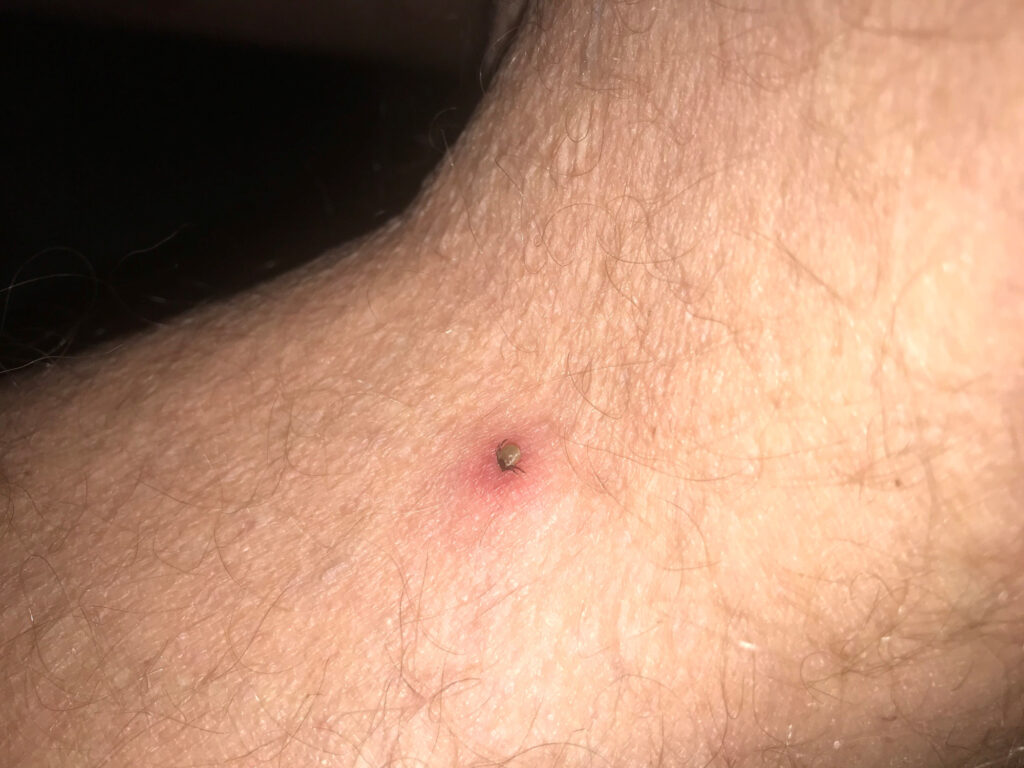
Photo of a Blacklegged (Deer) tick attached to a pale skinned individual, courtesy of NYS Integrated Pest Management Program, www.DontGetTickedNY.org.
Even adult ticks are small enough that they might not be noticed on your skin, especially in a hard to see area, so generally be on the lookout for any freckles you might notice being a bit darker than you remember.
An Important Note about Identification
An unfortunate and pervasive issue that is still ongoing with tick identification is a general lack of resources when it comes to identifying bites and rashes on darker tones of skin. Online resources for what to look for are extremely limited, and doctors can have a harder time identifying potential infections because of that.
Finding online resources for any skin condition on dark skin is a difficult task, and the way Lyme disease can appear on darker skin makes it extremely difficult to spot.
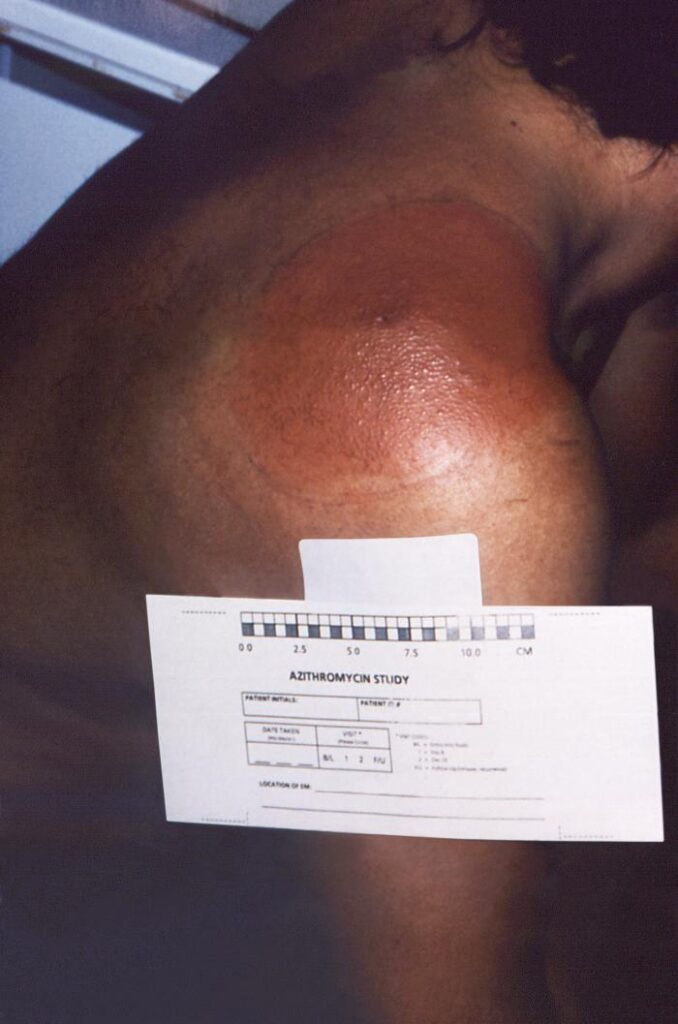
Pictured is a dark skinned individual with an EM rash on the right shoulder, courtesy of the CDC’s Public Health Image Library, https://phil.cdc.gov/Details.aspx?pid=14482
For these reasons and more we felt it important to highlight this here, as we unfortunately lack sufficient information to offer advice on this topic. If you personally have images or experiences removing or identifying ticks on darker skin, please feel free to send such examples to us at info@pinebarrens.org so that we might better update our information in the future. Know that we will never publish or share any images shared with us without express party consent.
The Risks
For most tick bites, the most you’ll have to deal with is a bit of a welt for a few days. In fact, if you accidentally remove or crush the tick without realizing it, you may mistake it for a mosquito or other insect bite.
The real danger though, comes from ticks which carry some form of infectious virus, the most well-known one being Lyme disease, a potentially serious disease should it not be treated immediately. Lyme disease is most recognizable by the bullseye rash it produces, which is commonly used to identify it. However, the rash will not always form in the traditional shape of a bullseye, and could be mistaken easily for a normal rash. On dark skin, the rash may appear as a slightly darkened patch of skin, but its circular shape should still be recognizable. In addition, while the rash will spread, if it occurs somewhere that is hard to see may hamper your ability to identify it.
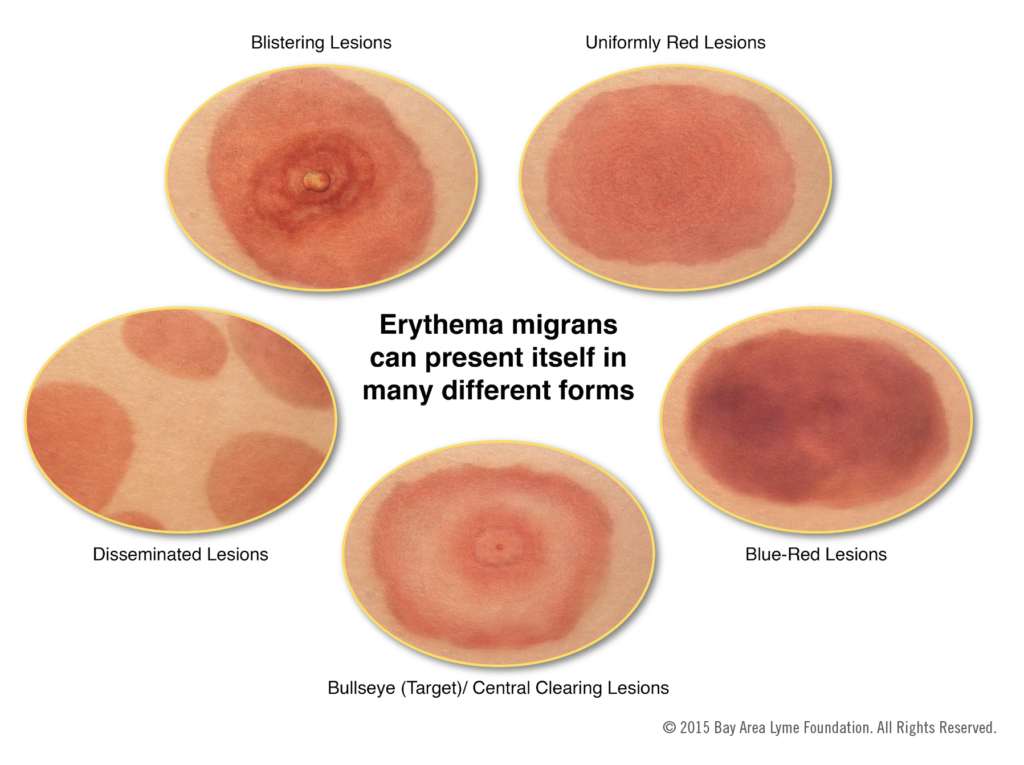
Illustration of various EM (expanding) rashes, courtesy of the Bay Area Lyme Foundation, https://www.bayarealyme.org/
For that purpose, it’s always recommended to go hiking in, at minimum, groups of two in order to check each other for ticks after a hike, removing the need entirely to twist or contort to see your back.
Lyme disease isn’t the only disease carried by ticks, though, and in fact it isn’t even the most serious. Some diseases, like Tularemia, don’t produce any rashes, and you’ll instead need to rely on a diagnosis exclusively. For that reason, it’s always recommended to save any ticks you find on your person to bring in to your doctor.
The variety with which rashes can manifest is to such an extent that, if you’ve been deep woods hiking recently and find a rash on your person that was not there before, it’s always wise to go to your doctor for a diagnosis. While ticks will burrow into the skin relatively firmly, there’s always the possibility that you can crush or remove them by accident.
Removing a Tick
When it comes to removing ticks, there’s a plethora of ways to do it, from old Boy Scout tricks to free little clips that come with your purchase of bike racks. Here, though we’ll just be going over the easiest and safest way to do it at home.
Once you’ve identified a tick, you’ll want to remove it using a pair of fine-tipped tweezers. Don’t use the kind that you might use for plucking hairs, since the sharp edges may separate the head from the tick’s body if you apply too much pressure. Once you have your tweezers, try to grab the tick as close to its head, or your skin, as possible, to minimize the risk of detaching the head. Pull the tick out with steady, even pressure, and avoid twisting or moving the tick if you can, since that, too, can increase the chances of a detached head.
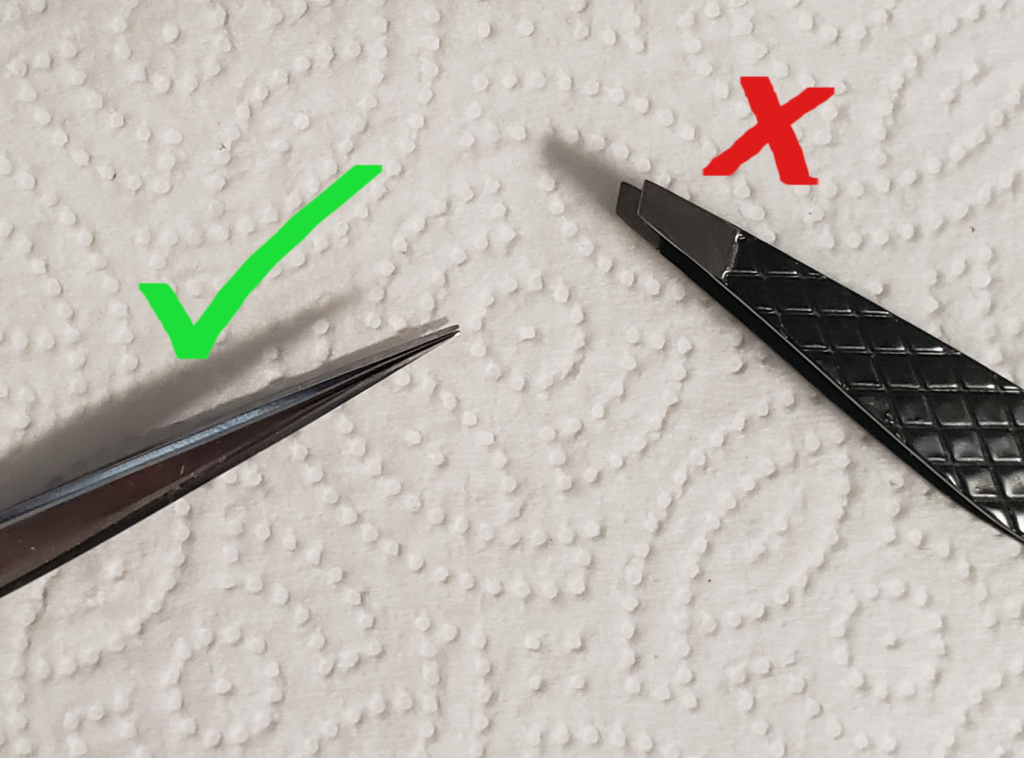
Once the tick is out of your skin, it’s a good idea to save the tick in a plastic bag so that any potential infections can be identified by a doctor. Mark the bag with the date and bite location, and put it in the freezer to kill and preserve the tick until you’re able to go to a doctor.
To treat a bite, first wash the affected area with soap and water, before gently wiping the area with a cotton swab dipped in medical grade alcohol. Always monitor a tick bite for any potential rash development, even if you do remove it as soon as it attaches.
Preventing Tick Bites
If you’d like to completely avoid the hassle and worry of removing a tick and needing to check for potential infections, the best way to do that is to stop them from getting on you entirely. Repellant is likely the first thing most people would look to to deal with any sort of insect, but there are steps that can be taken even before that.
Simply stated, it’s best to cover as much of yourself as possible. Wear long-sleeved shirts tucked into long pants tucked into long socks. If you have gloves tuck them into your shirt as well. As much of your skin as possible should be covered, including the hair, which is an easy place for ticks to hide in. For that purpose something like a bucket hat would be best, and if you want to make absolutely sure nothing is getting in your hair you can go the extra mile of wrapping your head in a bandanna or thin towel to cover your neck as well. All this advice is likely to sound absurd in the summer heat as we regularly breach 80 degrees F during the daytime, but they’re nonetheless important steps if you intend to do deep woods hiking.
Of course, ticks aren’t only in the deep woods, and can be along any trail or even in your backyard, which makes tucking your shirt a good practice. The clothes you wear should be a light color: white, tan, and light grey all apply. This helps not only with identifying ticks, but also in keeping you cool with the sun beating down on you. You would also want some form of DEET repellant to spray onto your clothes to be extra safe, and a separate repellant to apply to any exposed areas of skin.
When selecting a repellant, there’s no way to tell what somebody’s personal skin condition is and what chemicals may cause a negative reaction. For that reason, visit the EPA’s repellant searcher here. The searcher allows you to select exactly what chemical ingredient you want in your repellant, and can even offer a complete list of repellants if you’d prefer to do the research yourself. Generally speaking you’ll always want a repellant that contains DEET or Picaridin, but this tool helps with choosing exactly which ingredients you want to avoid, or include, in your repellant.
If you’re not too concerned with your skin sensitivity, though, something like the OFF Deep Woods Towelettes are recommended by The Strategist as a good all-around DEET repellant. When it comes to covering your clothes, a towelette is likely going to be somewhat inefficient, so The Strategist recommends the Sawyer Premium Permethrin Insect Repellent for Clothing. If you look for this on Amazon you may be taken aback a bit at the price tag, a whopping $58, but cheaper options are available on the same page that you may want to look into. Additionally, if you do choose to shop for these products on Amazon, and wish to support the Long Island Pine Barren Society in the process, you can do so through our Amazon Smile page, which will donate 0.5% of your purchase to our organization at no charge to you. Important to know as well about repellants meant for clothing, is that they are often ineffective when applied to the skin, and should only be used on clothing or equipment.
This covers just about all the common knowledge to know about tick prevention. Of course, everyone will have their own anecdotal advice and steps to take in both preventing and treating tick bites, but having a baseline in your mind will always help. And if you ever need a refresher on these details, you can check out our Detecting Ticks on Long Island Guide, a much more condensed version of what you’ve read here.
So armed with this knowledge, and hopefully a bottle of repellant, we at the Long Island Pine Barrens Society hope you’ll take the nice weather as a chance to experience the Pine Barrens in their most natural, beautiful state. And, if you need some recommendations for trails, check out our Hiking Guide or Park Passport!
By: Andrew Wong, Long Island Pine Barrens Society
Cover Photo: Erik Karits, via Unsplash

